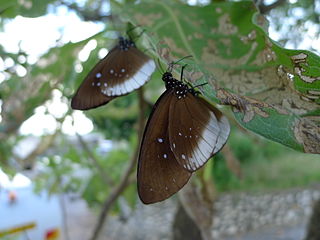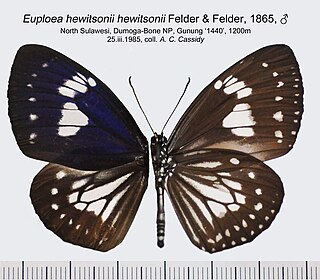
Hypolimnas is a genus of tropical brush-footed butterflies commonly known as eggflies or diadems. The genus contains approximately 23 species, most of which are found in Africa, Asia, and Oceania. One species, the Danaid eggfly, is noted for its exceptionally wide distribution across five continents; it is the only Hypolimnas species found in the Americas.

William Chapman Hewitson was a British naturalist. A wealthy collector, Hewitson was particularly devoted to Coleoptera (beetles) and Lepidoptera and, also, to birds' nests and eggs. His collection of butterflies, collected by him as well as purchased from travellers throughout the world, was one of the largest and most important of his time. He contributed to and published many works on entomology and ornithology and was an accomplished scientific illustrator.

Papilio (Chilasa) paradoxa, the great blue mime, is a swallowtail butterfly found in India and parts of South-East Asia. The butterfly belongs to the mime subgenus, Chilasa, of the genus Papilio. It is an excellent mimic of different species of Euploea.

Euploea klugii, the brown king crow or king crow, is a butterfly from the family Nymphalidae found in India and Southeast Asia. The species was first described by the entomologist Frederic Moore in 1858.

Euploea is a genus of milkweed butterflies. The species are generally dark in coloration, often quite blackish, for which reason they are commonly called crows. As usual for their subfamily, they are poisonous due to feeding on milkweeds and other toxic plants as caterpillars. The latter are aposematically colored to warn off predators from eating them, and the adult butterflies are often mimicked by unrelated species which are not or less poisonous.

The palmflies are a common Asian butterfly genus found from India to the Solomon Islands. The caterpillars mimic leaves which they feed on. The adults mimic certain species.

Euploea climena is a butterfly in the family Nymphalidae. It was described by Caspar Stoll in 1782. It is found in the Indomalayan realm and the Australasian realm.

Euploea hewitsonii, or Hewitson's dwarf crow, is a butterfly in the family Nymphalidae. It was described by Cajetan Felder and Rudolf Felder in 1865. It is found in the Australasian realm.

Euploea usipetes is a butterfly in the family Nymphalidae. It was described by William Chapman Hewitson in 1858. It is endemic to New Guinea and neighbouring Cape York Peninsula in the Australasian realm.

Elymnias malelas, the spotted palmfly, is a butterfly in the family Nymphalidae. It was described by William Chapman Hewitson in 1863. It is found in northern India and Indochina in the Indomalayan realm.










